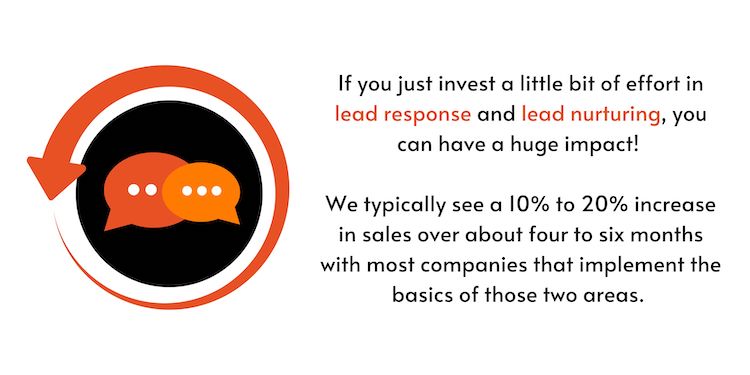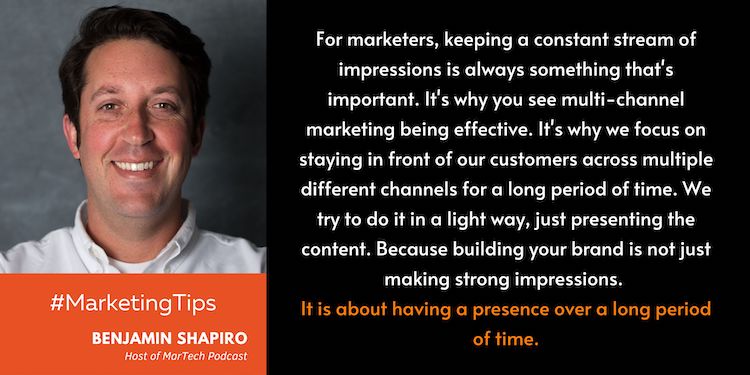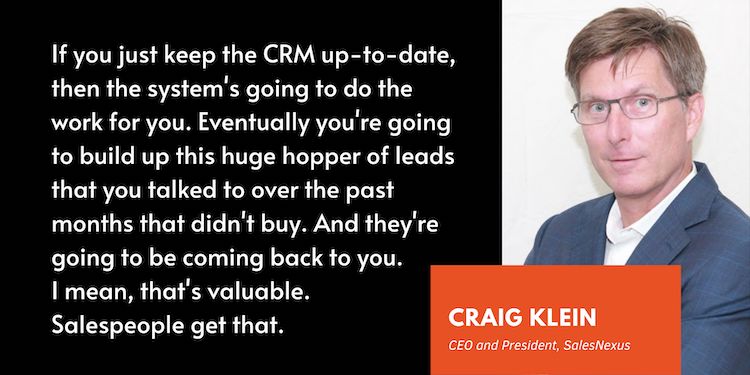With the online CRM solutions available today, you can integrate your sales and marketing strategies to nurture your leads.
In this podcast, SalesNexus CEO Craig Klein speaks with MarTech Podcast host Benjamin Shapiro about the reasons small-medium businesses could take advantage of an online CRM solution to service their customers and scale their business. Learn how to connect with your customers, take them through your sales funnel, nurture your leads, and optimize your digital marketing investments with a reliable online CRM solution.
Bridging the line between Marketing and Sales
BS: The first thing that sticks out to me is that online CRM solutions are big sales-driven organization tools. Although it’s not necessarily a marketing tool, it’s a way to build relationships on the sales side of the house.
CK: You just pointed out the main problem that most organizations (regardless of size) deal with: the line between marketing and sales. When we started SalesNexus, that was the first thing that hit me over the head. I come from a sales background, and one of the uses of online CRM solutions is to organize the sales effort. However, we quickly learned that digital marketing was going to be essential to filling our funnel.
Moreover, there’s this big disconnect of measuring what was happening in the digital marketing part of things. And then what happens to those leads once they get handed off to a salesperson. We couldn’t really bring together all the data so that we could really optimize the whole process. So that’s where we’ve focused in terms of delivering solutions to that problem for smaller businesses that don’t have the huge marketing and IT staff to figure all that out for them.
Areas for growth for SMBs
BS: I feel like technology has become more advanced, right? The ‘sales forcification’ of online CRM solutions and some marketing technologies. There’s been providers like yourself, HubSpot, Pipedrive – all are a bit of a different take on how you recognize who the actual people are.
CRM is customer relationship management. It’s about building one-to-one relationships with a person and a prospect. Talk to me about why an online CRM solution is essential specifically for SMBs – for small and medium-sized businesses.
CK: Well, to me, there are two things that SMBs really don’t do well. And have a huge ROI for them if they invest even a little bit in them.
- Lead Response – Most SMBs, based on our experience over the last 15 years. When you talk about the response to digital marketing, sales leads that are coming through your website, or calls that are coming in based on digital advertising, they’re doing a terrible job of responding to those leads. They are waiting too long. They’re not handling them properly. They’re not following up enough.
- Lead Nurturing – They’re not nurturing the leads. The people that come into the funnel initially, and then don’t buy right away. They get thrown over the salesman’s shoulder and into the waste bucket and they forget about them.

Taking your customer through the CRM funnels
BS: You’re saying that there’s a process for the merger between marketing and sales. And I think the line is a little gray here. When somebody gets through your website, fills out a form, gives you a phone call, or leaves a message. There’s the initial onboarding. How do you make sure you’re maximizing the purchase intent or the interest that they have at the time of them filling the form and keep the iron hot? And then if you’re not able to get to the close, how do you keep a relationship with somebody? Eventually, there’s a third part of getting them across the finish line. And that is very much traditional sales. What are the stages that you set up in a CRM or the “funnels” in marketing terminology?
CK: Well, of course, it really depends on the market that you’re in. When we’re talking about salespeople, we’re mostly talking about B2B with some exceptions. With B2B, the organization typically is very sales-driven. Marketing is there because it has to be. Especially in a medium-sized company, the salespeople are what the executives envision as their connection to the marketplace.
Transitioning customers into digital marketing
So that creates this divide between the two groups right out of the box. For example, we’re here in Houston with lots of energy-related companies. These are companies that have been hugely successful for 20 – 30 years. They’re very sales-driven. And then for whatever reason after decades of sending salespeople out to go knock on doors, the lights go on. Then they’ve decided, “You know what? We need to start investing in digital marketing.”
Now here they are trying to inject these new types of opportunities into an old-school sales team. So we find ourselves very often helping customers manage that transition. If you don’t come at it as a marketer with the perspective of a marketer. Knowing as you mentioned earlier, the mindset of a buyer when they engage with that form, and really thinking about that and building a process that’s based upon that journey that the buyer needs to go through. Then you’re really going to damage the ROI on the entire campaign. So it’s a cultural change, ultimately.
The overlap between Marketing and Sales
BS: Talk to me more about the overlap between marketing and sales. I mentioned at the beginning of the podcast that online CRM solutions are traditionally a sales-driven tool. But now there is the notion of the blending of CRM, understanding the relationship marketing email, and even prospecting is building into CRM. Where does the marketing part start? Where does it overlap with sales? And when is it really just the sales team’s responsibility?
CK: Ultimately they’re both overlapped completely. In a perfect world, that’s the way it would work. Because even when I’m closing a deal as a salesperson, there are messages that my customers are going to receive one way or the other. My retargeting ads or the email campaign they happen to be on, in a perfect world, those should all work well together.
In the end, that’s what we try to achieve. That’s kind of an ideal. And it’s not as if there’s no technology out there that does all of this. We’re different in that we’ve simplified it and combined it into one solution. That’s easy for a medium-size organization that doesn’t have the big back-office staff to manage, connect, and maintain it all.
How the sales process drives the marketing messages
The way we make things work for our customers is the sales process instantly drives the marketing messages. As soon as you come in as a conversion and engage with a salesperson, we begin to learn information about you. All that goes into the online CRM. Then that changes the messaging that you’re seeing. So even as you’re down at the closing end of the funnel, the CRM is using that information to change the messaging that you’re getting. Although that’s in a perfect world. Most companies developing all the content that would be needed to support all of the nuances in their sales process is probably a little bit beyond their scope.
BS: So what you’re saying is basically the marketing automation component of SalesNexus, the way that your platform works is as someone moves through one of the pipeline stages, it would change the language that’s being sent out to them using the marketing automation technology.
CK: That’s right. And you described it as stages. Typically what we see is at the top of the funnel is the need to focus on the customer’s pain. What is the problem that they have that drove them to fill out your form? Let’s stay focused on that at the top of the funnel.
Once you’ve uncovered an opportunity, then it’s really at that point more about establishing credibility. So that’s where things like case studies, testimonials, and things like that come into play. Just that one little change – being able to automatically switch somebody from a, “You have a problem, we have a solution” type of email campaign to a “Here’s how we’ve yielded success for our customers” type of campaign as they move through the funnel. Just that one little change can be huge.
Nurturing leads using marketing
CK: Certainly the marketing messages have to reflect the sales approach as well. We talked about earlier being able to nurture leads in this way. As when the salesperson just gives up. Once they go, “This deal’s not going to close. I’ve got to focus on the people that I am going to close this month, so I can hit my numbers.” We want to make sure that those people go on to some kind of drip campaign.
That’s where I see most companies just really are missing an opportunity because in B2B, for sure where it’s not so much of an impulse type. The reason people don’t buy is almost never because they’re saying “I don’t want to ever do business with you.” It’s almost always other things that are really out of the control of the brand. It’s things like, their budget, the unavailability of the decision-maker, or being in a contract with another vendor.
BS: I’ll use a dating metaphor: It’s the right person, right place, right time. And if one of those variables is out of whack, you’re either not getting a first date or you’re not selling your services.
CK: Therefore, you just got to be there. Six months from now, when something changes in their world, and all of a sudden it’s the right time. You want to be the last message they got.
Nurturing your leads
BS: Talk to me a little bit more about that nurture phase. When you’re going through the pipeline. You’re learning about them. You’re trying to build credibility or you’re actually getting to the point where you’re selling, and they’re just not ready at that time or there’s something that’s missing. How do you keep the relationship alive and how do you still preserve some momentum? So when they are ready, you are top of mind.
CK: It can be more nuanced than this, of course. At a really simple level, you want to go back to the pain. Additionally, just keep offering valuable content. That’s basically saying, “Hey, if you have this problem, then here are some tips. Here are some tricks. Here’s some interesting stuff that may be helpful to you.” So that’s how you’re going to keep that line of communication open as long as possible. If you keep going for the close in your email messages, eventually you’re going to annoy them and turn them off, and they unsubscribe.
Therefore, you want to go back to – “I can just be helpful here. Once your problem gets significant enough that you need more help than what I’m sending you, then call me. I’m here. We’ll talk about how it can help in other ways.”
Focusing on the customer’s pain
BS: That’s interesting. I would think that the nurture content changes depending on where someone is in the funnel, right? If somebody is in the “learn” phase, doing nurture content that talks about how to address the pain, makes sense. If somebody gets to that credibility portion, and they’re not ready to move forward, you’re not necessarily saying, “Hey, here’s more information about why we’re credible.” You’re going back and saying, “Is this still your pain point?” Is that because you’re simplifying the process here? Or is that really a best practice? No matter where someone is in the funnel, just keep reminding them that there is a way to address the pain that they’re feeling?
CK: As I said, it can be more nuanced. For instance, you may have a major competitor that when you close a deal, it’s almost always for them. Well, when you know, that’s what happened in a given deal, maybe you want a set of messages that really contrast you with that competitor.
I try to keep it pretty simple. Especially for a medium organization. Those who are just jumping into this for the first time. It doesn’t have to be very nuanced. What you’re wanting to do is just maintain brand awareness over a period of time. That’s 90% of the battle.

Reasons SMBs don’t have a CRM solution
BS: Craig, any last words for today about why SMBs need a CRM solution? What’s the biggest reason why they don’t have one?
CK: Well, the Achilles heel of the CRM world, of course, is that salespeople hate using them. So that’s the biggest reason why most companies don’t have them. The management just hasn’t figured out a way to twist anybody’s arm enough to get them to use it. So that’s another reason why doing this type of thing to me is a win-win for everybody involved. It’s a win for the business because what you’re doing is you’re giving the salespeople a reason to play the game with the CRM.

Advantages to having an online CRM solution
CK: The flip side of that is that there’s a huge win for the marketing group as well. In a small-medium-sized business, maybe they’re making that first big investment in say, Ad Words to drive traffic to the site. Well, the first thing they’re going to find out is they can drive conversions with all sorts of different techniques and tactics in Ad Words. But then they hand them off to the salespeople. However, they have absolutely no way to know whether the leads that come from that landing page or that ad campaign are the ones that the salespeople are closing. They just lose the tracking.
Then going into the board meeting at the end of the quarter and reporting on the results of your advertising. You can say “I spent a hundred thousand dollars in this quarter… I got X number of leads… I got this number of conversions.” Unfortunately, that’s all you can say because the sales guys are not going to give you credit. They’re not going to say, “We hit our numbers this quarter because of all those great leads from marketing.” Instead, they’re going to say, “It was our wonderful selling.” So you’ve got to be able to tie that together. And if you don’t have all this information in one system, you really can’t.
Optimizing your digital marketing investments
CK: That’s one thing that I’m really excited about. We just released a new capability that literally tracks the conversions coming in based on Ad words, Ad groups, and that kind of fine detail. As a result, you can do a pipeline report and a close report that says, “I might be getting a lot of conversions from this ad where I’m spending a lot of money advertising. But I’m not closing very many. But over here, I’ve got this ad campaign that I’m not really emphasizing or spending a lot of money on. Moreover, percentage-wise, I’m closing a bunch of those leads. So let’s redirect that advertising spending based on what’s happening in the sales process. That’s a huge game-changer in terms of optimizing your digital marketing investments.
BS: I think that’s a good point is that an online CRM solution allows you to capture the data. Not only from your marketing efforts but connect it to sales. So you’re able to see end-to-end from what campaign is driving impressions to web conversions and form fills, and then are those actually being closed and producing revenue.
And so that end-to-end reporting is something that’s really powerful to not just optimize, to drive people to and through your website, and make sure they’re actually creating business results.
LEARN MORE
The MarTech Podcast tells the stories of world-class marketers who use technology to generate growth and achieve business and career success.
Visit https://martechpod.com/ for expert knowledge & insider information from marketing & technology industry leaders. You can also check out this episode on the MarTech Podcast website: https://martechpod.com/episode/why-smbs-need-a-crm-solution-to-service-craig-klein-salesnexus/